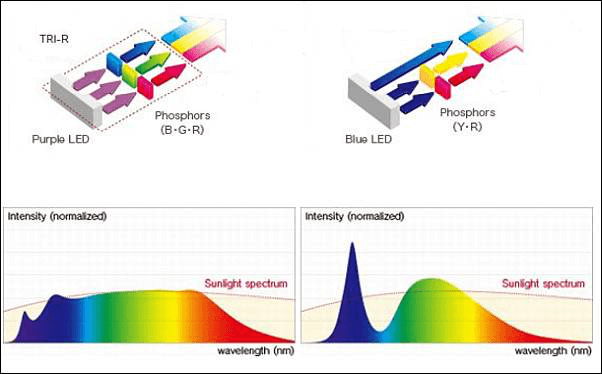Blindness! The “SunLike LED” that you have neglected turned out to be a black technology.

“The white LEDs with blue LEDs will disappear sooner or later.” I don’t know if the LED industry people still remember this sentence. This is the father of the blue LED, the 2014 Nobel Prize in Physics, Santa Barbara, University of California, USA. Professor of the branch school (UCSB), Nakamura Shuji.
This is a sentence two years ago. Why do you want to talk about it again today? This starts with the recent SunLike series of products jointly launched by Seoul Semiconductor and Toshiba Materials. From the propaganda of this product alone, I can’t see what it is. So online Jun also found out the relevant information of the day’s press conference. Originally, this product uses the technology of purple light to stimulate RGB phosphor to achieve white light illumination.
“Blue light hazard” is gone?
The incandescent lamp went down the altar and the LED was on the stage. There are various “hazards” in LED lights, and from time to time on the Internet, the argument of “damaging the retina and greatly affecting the eyes” has arisen.
“LED blue light will damage the retina” “LED blue light has a great impact on the eyes” “Uncover the secret behind LED blue light”… For consumers who have eliminated incandescent lamps and all of them are equipped with LED light sources, everyone There is no solution to the LED Blu-ray in addition to using the detection standard.
At present, LED lighting uses blue LEDs to excite phosphors to produce white light illumination. Because of the high intensity of blue light in the spectrum of white LEDs in this technical solution, it is threatened by blue light, although the current official institutions have indicated that LEDs Blu-ray is safe in the standard, many people still “talk about blue change.”
Seoul Semiconductor’s SunLike LEDs use white LEDs to excite phosphors to obtain white light illumination. The peak intensity of blue light is not too high, so there is no blue light hazard.
In addition, the purple LED is fabricated using a GaN substrate, and the crystal quality is relatively high, and there is almost no difference in lattice constant, crystal defects are hard to occur, and the luminous efficiency is high and the efficiency is improved.
In addition, since the purple LED chip is triangular, the light extraction efficiency is higher, the electro-optical conversion efficiency can be as high as 84%, and the electro-optical conversion efficiency of the ordinary blue LED is only 50 to 60%. What’s more worth mentioning is that the purple LED chip is not prone to the “droop” problem.
The crystal quality of the GaN on GaN type product is high, and the light effect is less likely to occur than the sapphire substrate type product. Compared to sapphire substrate type products, GaN substrate type products can increase current density by 5 to 10 times.
This is consistent with the remarks made by Nakamura Shuji in the past. Of course, there are still many problems in the realization of LED lighting by violet light, and its development is also affected by the supporting materials, equipment, and the supporting level of the industrial chain.
Real “full spectrum” LEDs are implemented?
The concept of the full spectrum I think everyone is no stranger to it. At present, the promotion of such products is dominated by phosphor companies. However, the current mainstream method for achieving high-intensity LED white light in the industry is to increase the red powder excited by changing the phosphor material. Although this method improves the color rendering, the red powder is greatly affected by the excitation spectrum and temperature. The heat emitted during use changes the red-white spectral characteristics of the LED white light.
The direct consequence of this change is that the color temperature change and color rendering decrease with the increase of the lighting time of the product, and the decrease of the light efficiency caused by the weakening of the excitation efficiency also occurs. Although this can improve the light quality of the illumination LED light source, it can greatly improve the spectral continuity, color gamut saturation, and color rendering index of the illumination LED light source, effectively reducing the blue light hazard, but at the same time sacrificing some light effects, this is not really The full spectrum in the sense.
The white light illumination LED produced by the violet excitation can output all the light in the visible wavelength range, so that the ideal white color like sunlight can be realized, that is, the full spectrum.
The white light spectrum of Seoul SunLike LED violet and blue light excitation

Source: Seoul Semiconductor
Compared with blue-light-excited white-light LEDs, the advantages of violet-excited white-light LEDs are obvious, but there is also the biggest cost-effectiveness problem. Therefore, Seoul Semiconductor has introduced this product into COB products and introduced it to Seoul MJT (multi-joining technology). The medium-voltage package of high-voltage LEDs has a large layout for high-end commercial applications.
From a technical point of view, the white light LED scheme excited by violet light is indeed better than the blue light excitation. If the cost can be lowered, it may be the same as that mentioned by Nakamura Shuji, but it is currently at cost.

